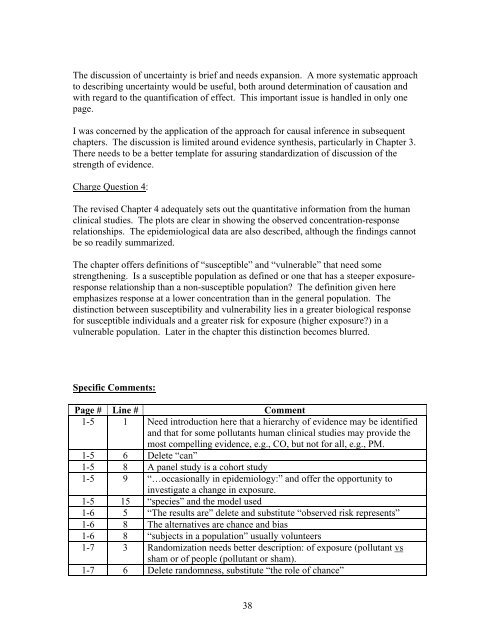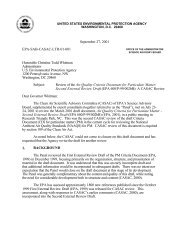(CASAC) Peer Review of EPA's Integrated Science Assessment
(CASAC) Peer Review of EPA's Integrated Science Assessment
(CASAC) Peer Review of EPA's Integrated Science Assessment
You also want an ePaper? Increase the reach of your titles
YUMPU automatically turns print PDFs into web optimized ePapers that Google loves.
The discussion <strong>of</strong> uncertainty is brief and needs expansion. A more systematic approachto describing uncertainty would be useful, both around determination <strong>of</strong> causation andwith regard to the quantification <strong>of</strong> effect. This important issue is handled in only onepage.I was concerned by the application <strong>of</strong> the approach for causal inference in subsequentchapters. The discussion is limited around evidence synthesis, particularly in Chapter 3.There needs to be a better template for assuring standardization <strong>of</strong> discussion <strong>of</strong> thestrength <strong>of</strong> evidence.Charge Question 4:The revised Chapter 4 adequately sets out the quantitative information from the humanclinical studies. The plots are clear in showing the observed concentration-responserelationships. The epidemiological data are also described, although the findings cannotbe so readily summarized.The chapter <strong>of</strong>fers definitions <strong>of</strong> “susceptible” and “vulnerable” that need somestrengthening. Is a susceptible population as defined or one that has a steeper exposureresponserelationship than a non-susceptible population? The definition given hereemphasizes response at a lower concentration than in the general population. Thedistinction between susceptibility and vulnerability lies in a greater biological responsefor susceptible individuals and a greater risk for exposure (higher exposure?) in avulnerable population. Later in the chapter this distinction becomes blurred.Specific Comments:Page # Line # Comment1-5 1 Need introduction here that a hierarchy <strong>of</strong> evidence may be identifiedand that for some pollutants human clinical studies may provide themost compelling evidence, e.g., CO, but not for all, e.g., PM.1-5 6 Delete “can”1-5 8 A panel study is a cohort study1-5 9 “…occasionally in epidemiology:” and <strong>of</strong>fer the opportunity toinvestigate a change in exposure.1-5 15 “species” and the model used1-6 5 “The results are” delete and substitute “observed risk represents”1-6 8 The alternatives are chance and bias1-6 8 “subjects in a population” usually volunteers1-7 3 Randomization needs better description: <strong>of</strong> exposure (pollutant vssham or <strong>of</strong> people (pollutant or sham).1-7 6 Delete randomness, substitute “the role <strong>of</strong> chance”38
















